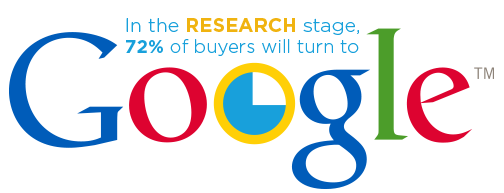We have all heard about the buyer’s journey and all of the different variations of it. Some companies prefer a process look, while others like McKinsey prefer a circular journey map. Neither approach to the buyer’s journey is incorrect; it is up to the company to decide which process is a better fit for their marketing. Here at Sponge, and previous companies I have worked for/with, tend to prefer the process look:


For this post we will walk three each of the three stages of the buyer’s journey discussing the importance of each, and explaining what we can do as marketers to help guide prospects to the decision phase.
>> Related: The Demise of Inbound Marketing? <<
Buyer’s Journey Stage 1: Awareness
The first stage of the buyer’s decision journey is the awareness stage. Since this stage is the beginning process of making a sale, it is important to keep in mind two caveats: your buyer is most likely unaware they have a need for your product, and that your buyer is unaware of your company. So how should marketers go about introducing themselves to prospects?
Need
Content generation is always a good idea when prospecting. Since your potential user has no idea who you are as a company and the solution that you provide, it is not a good idea to focus content on the pains of the consumer rather than promote your product or brand.
Research
When done correctly, identifying a pain point of prospects you invoke them to begin progressing down the awareness stage and begin researching.


Be responsible and have resources readily available on your website and other mediums users come in contact with frequently with your company. Use marketing automation to track downloads of your content and turn that information into a prospect list. At this point you are not ready to pitch your product or service yet, but you can begin forming a buyer’s persona based-off your prospect lists to help cater your marketing/sales message later on.
Criteria
Lastly, when it comes to the awareness stage, prospects will begin to prioritize what is important to them. Prospects will eliminate vendors that they feel don’t provide the product or service that they are looking for. Marketers can avoid being eliminated from consideration by providing prospects with lead nurturing campaigns. This could be promoting industry reports or white papers; this helps show your company’s product/service relieves the prospects pain.
Buyer’s Journey Stage 2: Consideration
At the consideration stage, prospects have narrowed their list to a handful of possible matches. Now that their list has been trimmed, they will go back to the research stage and begin to dig deeper into what companies have to offer. Research shows that 70% of buyers will return to Google 2-3 times during the course of their research. This means that companies need to have a prospect scorecard and continually update it as prospects take valuable actions.
Comparisons
At some point during a prospects research, they will begin to compare and contrast vendors in terms of benefits and downfalls. Usually at this stage prospects will begin reaching out to sales reps from the companies they are interested in. This makes it important for the marketing and sales teams to have a cohesive message being presented to prospects. You cannot have the marketing team creating content about different benefits/solutions than those that the sales team focuses on when selling.
Justification
Before a purchase is made, upper-management is most likely needed to sign-off on the expense. When making the case for the purchase, the prospect will have to use words that resonate with executives such as increased revenue and ROI. Marketers need to have content readily available to support these key terms for executives to see monetary upside in making a purchase.
Marketing Metrics for Executives (source)
Buyer’s Journey Stage 3: Decision
The final stage of the buyer’s decision journey is the decision stage where consumer make the final judgement on whether or not to purchase your product. If your buyer has been cleared to make the purchase, then they will do so. Just because a product/solution is sold though, does not mean all is right in the world. No! Marketers still need to push content that is aimed at displaying the application of their product/solution. A good way to go about this is to create a guide that takes users from easy beginning stages, to an advanced user as they progress further into the guide.
Loyalty
Loyalty to a brand is every marketer’s dream. You want your buyers to have an easy time progressing through the sales and marketing funnel, and then have satisfaction with your product/service. When these things happen buyers are happy which leads to loyalty to your company. The best part about having customer loyalty, is that they can become brand advocates for your company. 88% of consumers trust online reviews as much as personal recommendations.


As marketers, we need to be able to present the right information to customers at the right time. Supplying the wrong information to a prospect, or pushing too hard for a sale, can discourage them from making a decision to purchase. To avoid this, it’s important to always know where a prospect is in the buyer’s journey. Keep an updated CRM system such as Salesforce to track a prospects advancement through each stage of the buyer’s journey. Be sure you are presenting the proper content to them prospect for the stage of the buyer’s journey that they are in; and also communicate often with the sales team to promote a single coherent message to the prospect. By always being aware of where a prospect is in their purchasing decision, you will see greater conversions rates from lead to sales.
Image via Giphy
Real talk: you don’t need another infographic!
This Buyer Journey template maps what content (and what formats) you need for each stage of the buying process.




